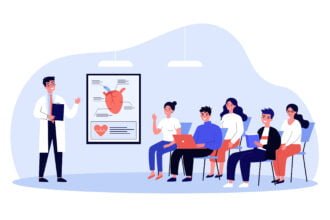Approximately half of the medical schools across the country have student-run clinics, medical clinics that are often started, operated, and managed by students. There are about 110 total in the United States. They are highly popular among medical students – the AAMC Medical School Graduation Questionnaire shows that of 13,681 recent medical school graduates, over 70 percent have had experience with a free clinic for underserved patients. They are entirely volunteer-based and typically have two primary goals: the provision of care to the underserved and medical student education.
Towards the first goal, most SRC patients are minorities and nearly all are uninsured. While the design, focus, and operation of SRCs vary, it’s safe to say that all SRC patients are biopsychosocially complex. Data from my own dear SRC, University of Florida’s Equal Access Clinic, shows the complexity of our patients. Nearly 95 percent have more than one chronic condition; nearly half of patients describe their mental health as poor most days in the past month; 20 percent have three or more mental disorders; and 100 percent of patients are uninsured (data unpublished as of press time).
Given that SRCs provide care for the community’s vulnerable patients at an average of 36,000 patient visits per year, it’s clear that they are an important part of the safety net that medical schools provide. They also represent a venue for valuable educational opportunities for medical students. They support medical education in three ways.
1. SRCs are highly interprofessional. AAMC data shows that approximately 10 percent of medical school graduates describe their teamwork experience with other professionals as inadequate. SRCs effectively meet this educational goal. Clinical operations are professionally integrated: At our clinic, medical students work alongside social workers and students from pharmacy, physician assistant, dental, physical therapy, masters of public health, pre-medical, and clinical psychology Ph.D. candidates. For three years, the top levels of the clinic’s leadership have included students from disciplines outside of medicine. As a clinical psychologist-in-training working at one of the clinics, I am part of the plan of care for most patients, along with representatives from at least four other disciplines.
2. Data from the Equal Access Clinic system (unpublished as of press time) shows that 45 percent of patients seen would not have sought care had the clinic not been available. Those at SRCs know their time spent caring for people in their community is invaluable to each and every patient, promoting a sense of altruism and compassion for people from whom the social determinants of health are so prominent. Additionally, given today’s trend towards medical specialization, the community and the underserved can play a less prominent role. Regardless of intended specialty, SRCs likely facilitate this sense of community and altruism.
3. SRCs enhance knowledge about systems-level health care. Given the complexity of the health care system, systems-level knowledge is an understandable concern for nearly all medical educators. At SRCs, students learn crucial systems-level health care lessons. For me, working in a free clinic allows me to better understand the effects of insurance, billing, health care costs, and the true meaning of un- and under-insured in context.
Volunteering has an overwhelmingly positive impact volunteering on the medical (or other health profession) student. The literature on volunteering — a subset of positive psychology — shows that volunteering has a remarkable effect on the volunteer. This literature is rich with longitudinal cohort studies that show a 44 percent reduction in mortality among older (non-student) volunteers (controlling for age and sex) and increases in happiness, life satisfaction, self-esteem, sense of control over life, physical health, and decreases in depression. While no studies have examined the effect of volunteering at SRCs on med students, these effects are likely the same. However, each and every SRC clinic attracts its students in different ways: for some it is required, for others it is totally self-motivated. These incentive structures might alter the effect of volunteering at SRCs.
On a personal note, I served the Equal Access Clinic as a mental health director for two years and as a co-director of the clinic system for another two years. It has been an incredible experience that I treasure above nearly all others during my graduate school career. This year, I chose to step down as a co-director to become a volunteer again. I won’t pretend to know exactly why I made that decision, but I do know it feels great to re-connect with simply being a volunteer at a SRC.






